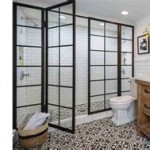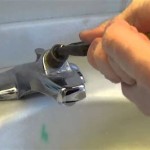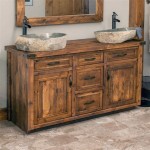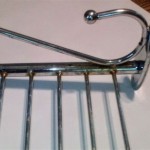Bathroom Sink Components: A Detailed Breakdown
A bathroom sink is a vital fixture in any bathroom, serving as a functional and aesthetic focal point. Its design and functionality are determined by a combination of interconnected components that seamlessly work together. Understanding the various components that make up a bathroom sink is crucial for both homeowners and professionals seeking to install, repair, or upgrade their sink fixtures. This article will delve into the essential components of a bathroom sink, providing a comprehensive overview of their functions and characteristics.
The Basin: The Heart of the Sink
At the core of every bathroom sink lies the basin, the primary component that holds the water. Basins are typically constructed from various materials, each offering distinct advantages and aesthetic qualities.
- Ceramic: This material is a popular choice for bathroom sinks due to its durability, affordability, and ease of cleaning. Ceramic sinks are available in various finishes, including white, off-white, and colored options, providing versatility in bathroom design.
- Porcelain: Similar to ceramic, porcelain sinks are known for their durability, resistance to scratches, and elegant appearance. They often feature a smooth, glossy finish that enhances the overall aesthetics of the bathroom.
- Stainless Steel: Offering a modern and sleek appeal, stainless steel sinks are highly durable and resistant to corrosion. Their smooth, non-porous surface makes them easy to clean and maintain.
- Cast Iron: Cast iron sinks are known for their exceptional durability and resistance to damage. They are often coated with enamel to prevent rust and enhance their aesthetic appeal.
- Acrylic: Acrylic sinks are lightweight and affordable, offering a smooth and glossy finish. However, they may be less resistant to scratches and heat compared to other materials.
- Solid Surface Composite: These sinks are made from a blend of resin and mineral fillers, offering a seamless and smooth surface. They are highly durable and can be molded into various shapes and designs.
The size and shape of the basin vary considerably, depending on the overall bathroom layout and personal preferences. Common basin shapes include circular, rectangular, and square, with various sizes ranging from small pedestal sinks to larger double-bowl vanity sinks.
The Faucet: Controlling the Water Flow
The faucet, an integral part of any bathroom sink, controls the flow of water, allowing users to regulate temperature and pressure. Faucets come in a wide array of styles and finishes, offering a vast selection to complement the overall bathroom design.
- Traditional: These faucets feature classic designs with intricate details, offering a timeless appeal. They often incorporate lever handles or cross handles for water control.
- Contemporary: Contemporary faucets prioritize sleek and minimalist designs, often featuring clean lines and simple forms. They may incorporate lever handles, push buttons, or sensor-activated controls.
- Modern: Modern faucets embrace innovative and futuristic designs, often featuring geometric shapes and bold statement pieces. They may incorporate sensor technology or sophisticated water-saving features.
Faucet finish choices are equally diverse, ranging from polished chrome and brushed nickel to oil-rubbed bronze and matte black. Each finish adds a distinct aesthetic to the bathroom, complementing the overall decor and style.
The Drain: Ensuring Proper Water Drainage
The drain is a crucial component that allows water to flow out of the basin and into the plumbing system. It consists of several parts, including a drain stopper, a drainpipe, and a trap.
- Drain Stopper: This component controls the flow of water out of the basin, allowing users to fill the sink or empty it. Drain stoppers come in various types, including push-button, lift-and-turn, and pop-up styles, offering convenience and functionality.
- Drainpipe: This pipe connects the basin to the drain trap and the main plumbing system, ensuring the smooth flow of wastewater. Depending on the installation method, it can be made of plastic or metal.
- Trap: This essential component prevents sewer gases from entering the bathroom, ensuring a hygienic environment. Traps are typically P-shaped, utilizing a small amount of water to block sewer gases.
Modern bathroom sink drains are designed to be efficient, durable, and aesthetically pleasing. They often feature sleek finishes and integrated designs, enhancing the overall look of the sink fixture.
The P-Trap: Preventing Sewer Gases
A critical component of the bathroom sink drainage system is the P-trap. This U-shaped or S-shaped pipe is located beneath the sink and serves a crucial purpose: preventing sewer gases from entering the bathroom. The P-trap holds a small amount of water that acts as a barrier, blocking the flow of gases from the sewer system back into the bathroom.
Without a P-trap, sewer gases could enter the bathroom, creating an unpleasant and potentially hazardous environment. The P-trap is an essential safety feature that contributes to a more comfortable and hygienic bathroom experience.
The Overflow Drain: Preventing Overflow
The overflow drain, a safety feature commonly found in bathroom sinks, prevents the basin from overflowing. Located on the side of the basin, the overflow drain allows water to drain out if the basin is filled beyond its capacity. This protects the bathroom from water damage and ensures a safe and functional environment.
The overflow drain is typically connected to the main drainpipe, allowing excess water to flow away from the sink. It often features a small, decorative cover that blends in with the overall design of the basin.
The Vanity: Providing Storage and Support
While not strictly a component of the sink itself, the vanity plays a crucial role in bathroom design and functionality. The vanity provides storage space for towels, toiletries, and other bathroom essentials. It also serves as a support structure for the sink, providing a stable and durable platform for the sink to sit upon.
Vanities come in a wide range of styles and materials, from traditional wooden cabinets to modern acrylic vanities. The design and materials of the vanity complement the overall bathroom decor, creating a cohesive and aesthetically pleasing space. The vanity serves as a functional and stylish complement to the bathroom sink, providing both storage and support.

20 Bathroom Sink Drain Parts How They Works Stopper Plumbing

How To Fit A Bathroom Sink Diy Guides Victorian Plumbing

Bathroom Sink Plumbing Diagram Diy Sinks Drain Kitchen Remodel

Parts Of A Sink The Home Depot

Bathroom Sink Parts Diagram Plumbing Drain Kitchen Remodel

Bathroom Sink Plumbing

Bathroom Sink Drain Parts Diagram Http Www Designbabylon Interiors Com Part Plumbing Kitchen
How To Install Bathroom Sink Drain Queen Bee Of Honey Dos
Bathroom Sinks 1 Rona

Repair Parts For One And Two Handle Delta Bathroom Faucets
Related Posts







